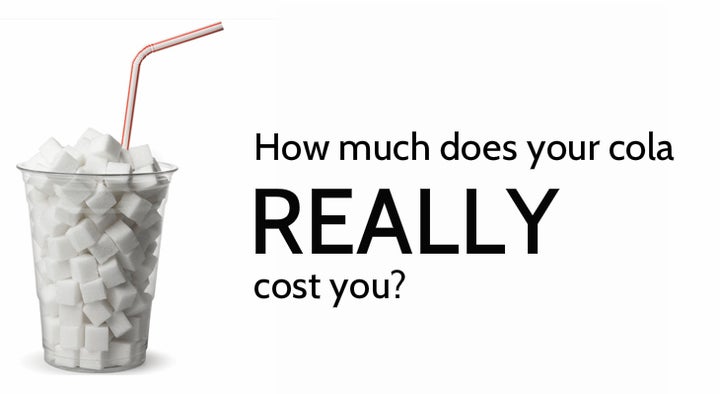
The line at the convenience store is three people deep. Standing in front of me is a 40-something man with a bottle of cola and a newspaper. In front of him, a mother paying her utility bill accompanied by her young daughter. The mum and child leave, and the man moves forward to pay. “Two dollars?” I overhear him say with surprise… “I remember when a bottle of cola was one!” As he pays and heads for the door, I too grab a newspaper and cannot help but notice the story on the front cover: the mounting crisis of costs from an obesity epidemic gripping not just the nation, but the planet – the economic and health systems already struggling to keep pace.
A cloud of sad irony descends on me as I struggle to make sense of this strange set of events. The frustration, not for this one man, but for the system we have collectively created where an individual is so far removed from the bigger economic picture beyond the pricetag of his seemingly expensive drink - when the truer price is vastly more costly. There is a sense of futility in the point that the small price he paid today was in fact the tiny tip of a much larger and deeply troubling fiscal iceberg; an iceberg into which our planet’s health is steadily and obliviously steaming full-pelt.
Then frustration turns to focus as I reaffirm that our greatest health challenges and the resulting economic strain on our societies – a concern shared by many – is not a challenge borne or solved by doctors in hospitals, but by economists, business people, policy-makers and market regulators. It is a challenge made in economics, and until these economic realities are understood, progress and especially solutions will remain elusive.
So what are these realities?
Well, when we pay for a cola, soda or any sugary drink, products we know are associated with weight gain, obesity and diabetes – we pay not one, but three times. Once with our dollars at the checkout, and twice more long after this initial transaction. It is these delayed payments that cause most of the trouble, as they lead to a problem called ‘market failure’. This is when the normal forces that define how much of the product is produced and importantly, how much of it we consume, become imbalanced due to unnatural manipulation.
In essence, and to paraphrase Churchill, what many of us overlook is that the costs this man paid for his cola at the counter were actually not the end, but rather just the end of the beginning.
Here’s why…
The price you pay at the counter
The first price we pay for our sugary drink is the few dollars we fork over at the cashier. For a product made from some of the cheapest commodities around – petroleum-based plastic we pump from the ground, water from the sky, and sugar often subsidized with our own tax dollars – a few bucks is a pretty steep price in itself. The cost of these raw constituents likely adds up to a few cents, and so the profit on our bottle for the producer is substantial. This is important, because it is this generous margin that allows billions to be spent annually by cola companies on advertising, lobbying policy-makers and even on paying the retailers – in this case the convenience store – to place their sugary products at eye height for children, paint the fridge with their colors or splash promotional wares throughout the retail experience.
This price is already high, and we are just getting started.
The price you pay after you drink
Let’s be really clear. Sugary drinks, soft drinks, soda or cola, whatever you call them, they’re bad news for our health. There are almost no other ‘foods’ that provide no nutrients but a significant proportion of our daily calories across the population. Science has clearly linked their consumption with obesity, child obesity, and diabetes. There is a clear social gradient in most societies – meaning the poorest members of most communities in wealthier nations drink the most, and increasingly vast numbers of people in poorer nations are taking up the unhealthy habit too. We know that our brain doesn’t recognize the calories in sugary drinks in the same way as solid foods, and these likely become ‘extra’ calories in addition to normal eating, or may even encourage further eating. And while it would be misleading to suggest that sugary drinks are the sole cause of the global obesity epidemic, we know that their consumption is one key driver.
When we add all this up, soda is very expensive to an individual, because obesity, diabetes and heart disease are expensive. Globally, they are the leading causes of death and key contributors to early (aka preventable) deaths. The health bills, time taken from work because of illness, the disability caused by complications of these debilitating, long-term illnesses and the loss of productive life due to premature death all add up to a huge cost on individuals and their families. These are not far-fetched sums or future, fantasy figures. These are a current, major drain on households across most nations today - the obesity epidemic is estimated to cost Australia over 56.6 billion dollars per annum, and individuals with obesity in America experience a 150% increase in medical spending compared with normal-weight counterparts.
The price you keep paying long after you stop drinking
The final cost relates to the fact that it’s impossible to put the genie, or in this case the fiscal fallout of sugary drinks, back into the bottle once it’s escaped. The collective, long-term cost across our societies is the most frightening figure of all – for at least two reasons.
The first is the ubiquitous nature of these drinks due largely to the decades of massive marketing campaigns that have normalized and even embedded these unhealthy products in our cultures as beloved and celebrated staples, markers of success and icons of Westernization. Quite simply, red and white cola signs are everywhere, in every city and nation I travel.
The second is due to the amount of these products that many of us now consume. In 2016, Mexico, the United States and Australia consumed 297.5, 270 and 145.3 liters of sugary drinks per capita, respectively.
The sheer scale of consumption and linked ill-health at the macro level is almost unfathomable. Collectively, the direct and indirect health costs across populations and health systems are unsustainable. For many low- and middle-income countries, what starts as a health challenge quickly becomes a barrier to poverty-reduction, and even economic development. The full price is felt eventually, and often by those least able to afford it.
The bitter truth to sugary drinks
Brilliantly profitable for the companies that produce them and the small handful of shareholders that enjoy the end financial windfall, the societal tsunami of health costs from sugary drinks is now lapping at our shores.
This is not about banning or blaming. This is about fair economics, and ensuring families, parents and communities understand the full and transparent picture of what sugary drinks cost, and can therefore make informed decisions about their consumption.
For too long, we have all unknowingly paid a very painful price for the sugary drinks we consume. Deferred, sometimes for years or decades, these costs eventually reap an enormous and bitter burden long after the sweet taste of consumption has left our mouths.
-

Dr Sandro Demaio works for the World Health Organization in Geneva. This post was written by Sandro in his personal capacity. The views, opinions and positions expressed in this article are the author’s own and do not reflect the views of any third party. Sandro is also co-host of ABC TV’s Ask The Doctor, on Australian television.